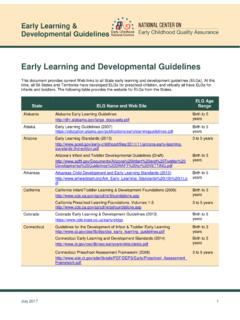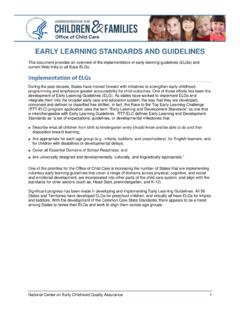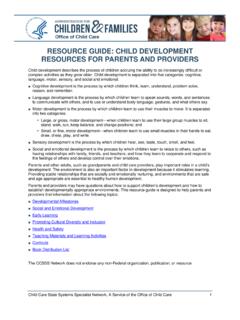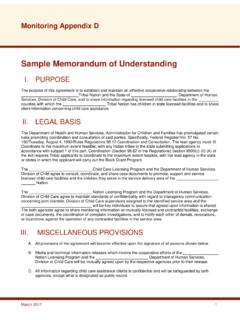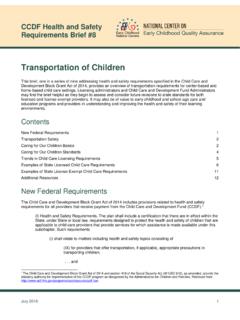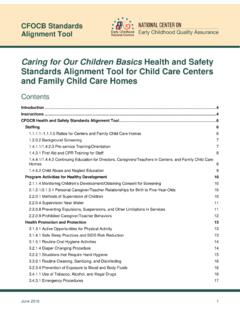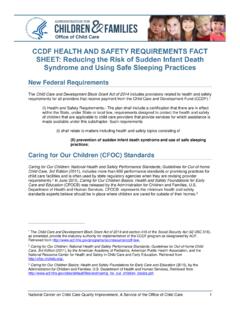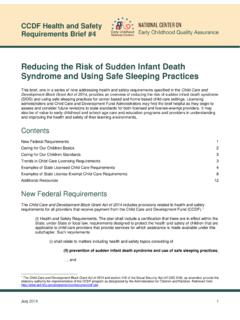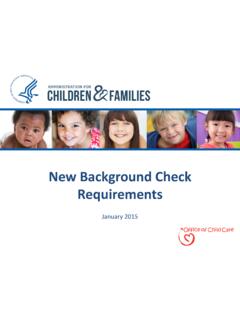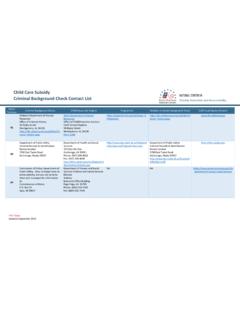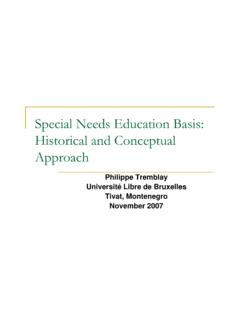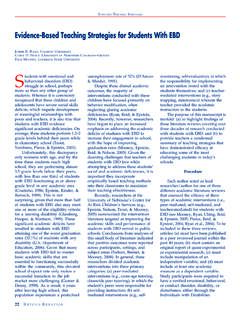Transcription of Child Development Resources for Families and Providers
1 resource Guide July 2020 1 Child Development Resources for Families and Providers Child Development describes the process of children gaining the ability to do increasingly difficult or complex activities as they grow older. Child Development is separated into five domains: cognitive, language, motor, sensory, and social and emotional . Cognitive Development is the process by which children think, learn, understand, problem solve, reason, and remember. Language Development is the process by which children learn to speak sounds, words, and sentences to communicate with others, and to use or understand body language, gestures, and what others say.
2 Motor Development is the process by which children learn to use their muscles to move. It is separated into two categories: Large, or gross, motor Development when children learn to use their large group muscles to sit, stand, walk, run, keep balance, and change positions; and Small, or fine, motor Development when children learn to use small muscles in their hands to eat, draw, dress, play, and write. Sensory Development is the process by which children hear, see, taste, touch, smell, and feel. Social and emotional Development is the process by which children learn to relate to others, such as having relationships with family, friends, and teachers; and how they learn to cooperate and respond to the feelings of others and develop control over their emotions.
3 Families and other adults, such as grandparents and Child care Providers , play important roles in a Child s Development . The environment is also an important factor in Development because it stimulates learning . Providing stable relationships that are socially and emotionally nurturing, and environments that are safe and age appropriate are essential to healthy human Development . Families and Providers may have questions about how to support children s Development and how to establish developmentally appropriate environments. This resource guide is designed to help Families and Providers find information about the following topics: Developmental milestones; Social and emotional Development ; Early learning ; Ways to promote cultural diversity and inclusion; Health and safety; Teaching materials and learning activities; Curricula; and Child Development Resources for Families and Providers July 2020 2 A book distribution list.
4 The State Capacity Building Center does not endorse any non-federal organization, publication, or resource . Developmental Milestones Back All children are unique and develop at their own rate. Developmental milestones are skills that children reach in their learning and growth, through experiences with adults, Families , and other peers. Developmental milestones are found within the following domains: social and emotional , physical, cognitive, and speech and language Development . The following table provides examples of some developmental milestones children from birth to 5 years of age may be able to accomplish by the end of each age range.
5 Birth to 5 Developmental Milestones Category Skills 2 months Social and emotional Begins to smile at people Can briefly calm himself (may bring hands to mouth and suck on hand) Language/Communication Coos, makes gurgling sounds Turns head towards sounds Cognitive Pays attention to faces Begins to follow things with eyes and recognize people at a distance Movement/Physical Development Can hold head up and begins to push up when lying on tummy Makes smoother movements with arms and legs 6 months Social and emotional Knows familiar faces and begins to know if someone is a stranger Likes to play with others, especially parents Language/Communication Responds to sounds by making sounds Strings vowels together when babbling ( ah, eh, oh )
6 And likes taking turns with parent while making sounds Cognitive Looks around at things nearby Brings things to mouth Movement/Physical Development Rolls over in both directions (front to back, back to front) Begins to sit without support 1 year Social and emotional Is shy or nervous with strangers Cries when mom or dad leaves Child Development Resources for Families and Providers July 2020 3 Birth to 5 Developmental Milestones Category Skills Language/Communication Responds to simple spoken requests Uses simple gestures, like shaking head no or waving bye-bye Cognitive Explores things in different ways such as shaking, banging, throwing Finds hidden things easily Movement/Physical Development Gets to a sitting position without help Pulls up to stand, walks holding on to furniture ( cruising )
7 2 Years Social and emotional Copies others, especially adults and older children Gets excited when with other children Language/Communication Points to things or pictures when they are named Knows names of familiar people and body parts Cognitive Finds things even when hidden under two or three covers Begins to sort shapes and colors Movement/Physical Development Stands on tiptoe Kicks a ball 3 Years Social and emotional Copies adults and friends Shows affection for friends without prompting Language/Communication Follows instructions with two or three steps Can name most familiar things Cognitive Can work toys with buttons, levers.
8 And moving parts Plays make-believe with dolls, animals, and people Movement/Physical Development Climbs well Runs easily 4 Years Social and emotional Enjoys doing new things Plays Mom and Dad Language/Communication Knows some basic rules of grammar, such as correctly using he and she Sings a song or says a poem from memory such as the Itsy Bitsy Spider or the Wheels on the Bus Child Development Resources for Families and Providers July 2020 4 Birth to 5 Developmental Milestones Category Skills Cognitive Names some colors and some numbers Understands the idea of counting Movement/Physical Development Hops and stands on one foot up to two seconds Catches a bounced ball most of the time 5 years Social and emotional Wants to please friends Wants to be like friends Language/Communication Speaks very clearly Tells a simple story using full sentences
9 Cognitive Counts 10 or more things Can draw a person with at least six body parts Movement/Physical Development Stands on one foot for 10 seconds or longer Hops; may be able to skip Note: This information is from the Centers for Disease Control and Prevention s Developmental Milestones section of its website at Although these milestones are based on age, achieving them varies from Child to Child . Families and Providers can help children reach developmental milestones by talking or playing with them or providing an environment that stimulates Development . Online Resources Parents Guide to Developmental Milestones ( ), Child Mind Institute, Milestones ( ), , What are developmental delays?
10 A developmental delay refers to a Child s inability to learn or master an expected activity within her age range. Developmental delays could be the result of either external or internal factors, such as a lack of environmental stimulation, premature birth, or a learning disability. Families and Providers can help children by learning the signs of developmental delay and knowing when to refer children to early intervention. The following organizations provide information about developmental milestones and developmental delays. Child Development Resources for Families and Providers July 2020 5 Organizations American Academy of Pediatrics (AAP) Phone: 847-434-4000 Website: AAP works to provide general health and well-being information for Families of children up to age 21.
